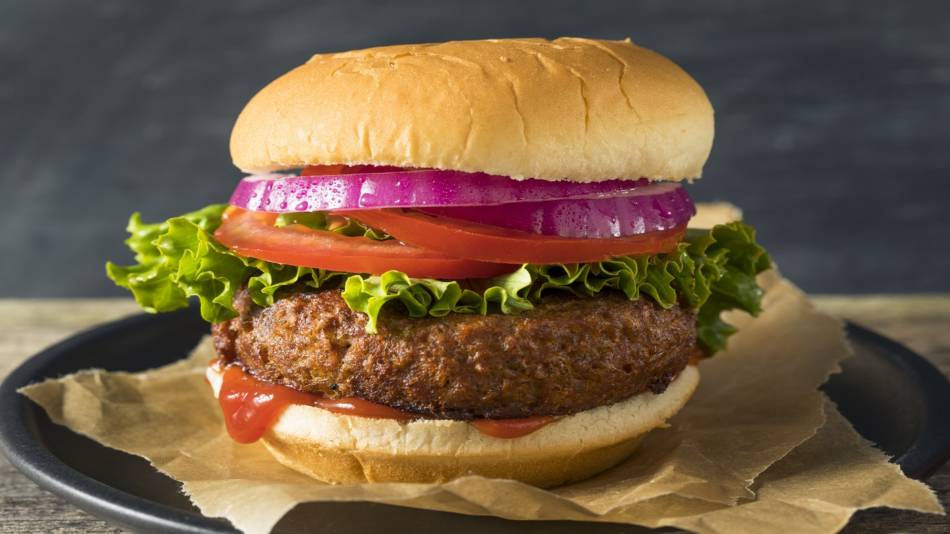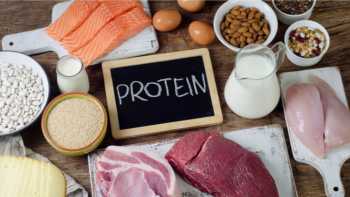Our Members Asked:
How do the Beyond Burger, the Impossible Burger, and a beef burger compare in terms of vitamins and minerals, and which is best?

Answer:
Burgers can be compared in many ways (e.g., taste, fats, protein, environmental impact, GMOs, amount of processing, etc.), but, as far as vitamins and minerals go, the Impossible Burger appears to be a better burger than the Beyond Burger because, as shown in the table below, it matches the many nutrients in a beef burger and goes beyond the Beyond Burger in of terms minerals — and way beyond it in terms of vitamins because the Beyond Burger lists none.
Below, we provide an in-depth comparison of the vitamins and nutrients, protein, fat and cholesterol content of the Impossible Burger, Beyond Burger, and a regular, meat-based burger, as well as an explanation about why certain nutrients in these and other meat alternative products may not be well absorbed.
While some research has linked plant-based diets with reduced risk of adverse cardiovascular events compared to diets that include meat (Ocagli, Nutrients 2023; Oussalah, Clin Nutr 2020; Kwok, Int J Cardiol 2014), there does not appear to be evidence that replacing meat with plant-based meat has heart-health benefits. In fact, an 8-week study in Singapore among 82 adults (average age 59) with elevated risk of diabetes showed that replacing 2.5 servings per day of meats with plant-based meats such as Impossible Beef, Beyond Burger, OmniMeat Mince, Chickened Out Chunks, Beyond Sausage Original Brat, or Little Peckers did not significantly improve measures of cardiovascular risk such as cholesterol or triglyceride levels, blood pressure, body weight, or blood sugar or insulin levels. Compared to meats, the plant-based meat analogues tended to provide more fiber (17.2 vs. 0 grams/day) but also more carbohydrates (33.5 vs. 5.3 grams/day). The plant-based meat analogues also provided more folate, calcium, and iron, but a similar amount of vitamin B12 (Toh, Am J Clin Nutr 2024).
B Vitamins
The Impossible Burger matches a beef burger in providing substantial amounts of vitamin B6. Impossible provides about twice the amount of niacin as beef (60% DV vs. 32% DV) and exceeds the 102% DV of vitamin B12 in a beef burger, providing 130% of the DV. Due to the difficulty some people have with extracting vitamin B12 from meat (a common problem among older people and those using acid-lowering medications), B12 may actually be better absorbed from the Impossible Burger than from a beef burger. Impossible Burger also provides more folate (20% DV) and riboflavin (15% DV) than a beef burger (just 2% and 5% of the DV, respectively), although only a beef burger provides choline (12% of the DV), which is particularly important for pregnant women.
In the past, a strange feature of the Impossible Burger was its very high amount of thiamin (2,350% of the DV) compared to none in the Beyond Burger and just 4% of the DV in a beef burger. The reason for such a high amount of thiamin was unclear as it was not just from natural ingredients but from thiamin listed as an added ingredient. Getting too large a dose of certain vitamins can be dangerous, but, fortunately, there is no established upper limit for thiamin and the amount of thiamin in the Impossible Burger now appears to be lower (only 40% DV).
Calcium and Potassium
Both meatless burgers provide more calcium than the 18 mg in a regular burger: Beyond provides 120 mg and Impossible provides 180 mg. Keep in mind, however, that certain plant sources of protein also contain phytate, which can reduce the absorption of calcium by making it less bioavailable (see below for details).
All the burgers provide some potassium.
Iron
The Beyond Burger and the Impossible Burger contain relatively similar amounts of iron (20% DV and 25% DV, respectively, which is about twice the amount in a beef burger), but the iron in Beyond Burger is likely to be much less bioavailable than the iron in Impossible Burger or a beef burger.
The iron in the Beyond Burger is non-heme iron, which has relatively low absorption (only about 1% to 10% of non-heme iron is absorbed compared to about 25% to 35% of heme iron, the form found in meat) (Skolmowska, Nutrients 2019). In contrast, the Impossible Burger contains iron in the form of soy leghemoglobin. Laboratory research suggests that the bioavailability of iron from soy leghemoglobin is similar to that of beef hemoglobin (Health Canda, 5-4-21).
Furthermore, the protein in the Beyond Burger is primarily pea protein with a small amount of rice protein and lentil protein, which contain an "anti-nutrient" called phytate. Phytate binds to non-heme iron, as well as zinc and calcium, in the gastrointestinal tract, forming insoluble complexes that cannot be digested or absorbed. A study showed an 82% reduction in iron absorption (from a food containing 4.1 mg of iron) if 250 mg of phytate was added (Hallberg, Am J Clin Nutr 1989). While the exact amount of phytate in the Beyond Burger is not published, it is possible that the product contains phytate in large enough quantities to significantly reduce the absorption of its non-heme iron. A study in Sweden of 44 meat alternative products — 14 of which contained mainly pea protein — found that average phytate content of the pea protein products (which included burgers, sausages, schnitzel, nuggets and plant-based "meatballs" prepared with varying percentages of pea protein) was approximately 350 mg per 100 grams of product (Labba, Nutrients 2022). (Note that phytate concentrations in pea protein powders are much higher than in foods made with pea protein.)
Zinc
Only the Impossible Burger matches a beef burger on zinc — each providing about half the daily requirement. Interestingly, in the Labba study described above, only meat alternative products derived from mycoprotein contained zinc at concentrations greater than 2.25 mg/100 grams, which is the lower limit for nutritional claims of zinc in the U.K.
Other vitamins and minerals
None of burgers provides significant amounts of vitamins A, C, D, E, or K. You'll need to get those from other foods or, if needed, supplements.
Neither meatless burger provides the small amount of magnesium in a beef burger or the moderate amount of selenium.
Both meatless burgers contain more than four times the sodium that is in a beef burger — a concern for people watching their sodium intakes.
If you want to find out your daily requirement of a vitamin or mineral, use the links in the first column of the table below which go to parts of our Recommended Daily Intakes and Limits table. From there you can also get to our reviews of supplements based on our laboratory tests of popular brands.
Fats, Cholesterol, and Protein
Upon publishing this article, we received reader comments asking us to include information regarding fat and protein in the burgers and how leaner beef would compare, so we've added information to the comparison table and the discussion below (Added 9/20/2019; Updated 4/11/2024).
For our original comparison, we chose to use a ground beef burger that was 84% lean, which is on the lean side for chuck but has slightly more fat than a Beyond Burger (14 grams) or Impossible Burger (13 grams). Leaner (and, typically, more expensive) beef will contain less fat and provide more protein (as discussed further below) but offers roughly the same amounts of vitamins and only slightly higher amounts of minerals.
The fat in a beef burger is about 50% saturated (the least healthy form). The fat in the Impossible Burger is about 46% saturated and the total amount of saturated fat is slightly less than in the beef burger. Fat in the Beyond Burger is only 14% saturated, amounting to four grams less of saturated fat than the Impossible Burger and five less than the beef burger. The saturated fats in the meatless burgers are due to sunflower oil and coconut oil in the Impossible Burger, and avocado oil in the Beyond Burger.
The Impossible Burger provides a little less protein than the beef burger (19 grams vs. 21 grams), while the Beyond provides the same amount. Of course, a burger made with leaner beef will provide more protein (a burger that is 95% lean contains 24 grams of protein, for example).
There is no cholesterol in either meatless burger, compared to 78 mg in the beef burger — about one-quarter of the maximum amount one should consume per day. Beef provides no fiber, compared to two to five grams of fiber in the meatless burgers. Beyond has an additional six grams of complex carbs and Impossible has four grams.
If you are at risk for kidney stones, be aware that, due to its soy content, the Impossible Burger likely contains more oxalate (which can contribute to stones) than the Beyond Burger, which is made with pea protein. (For more information, see our article about kidney stones.)
(Amount and % Daily Value per Patty or 4 oz /113 g Serving)
|
|
|
Beef Burger (84% Lean) | |
| Vitamins: | |||
| Thiamin | — | — (40%) |
0.047 mg (4%) |
| Riboflavin | — | — (15%) |
0.071 mg (5%) |
| Niacin | — | — (60%) |
5.162 mg (32%) |
| Pantothenic Acid | — | — | 0.609 mg (12%) |
| Vitamin B6 | — | — (20%) |
0.386 mg (23%) |
| Folate | — | — (20%) |
7 mcg DFE (2%) |
| Choline | — | — | 68.1 mg (12%) |
| Vitamin B12 | — | 3 mcg (130%) |
2.45 mcg (102%) |
| Minerals: | |||
| Copper | — | — | 0.075 mg (8%) |
| Calcium | 120 mg* (8% DV) |
180 mg (15%) |
18 mg (1%) |
| Iron | 4 mg* (20% DV) |
4.2 mg (25%) |
2.33 mg (13%) |
| Magnesium | — | — | 20 mg (5%) |
| Potassium | 370 mg (8%) |
700 mg (15%) |
328 mg (7%) |
| Phosphorus | — | 180 mg (15%) |
191 mg (15%) |
| Selenium | — | — | 17.7 mcg (32%) |
| Sodium | 310 mg (14%) |
370 (16%) |
75 mg (3%) |
| Zinc | — | 5.5 mg (50%) |
5 mg (45%) |
| Protein | 21 g | 19 g | 21 g |
| Total Fat: | 14 g | 13 g | 18 |
| Saturated Fat | 2 g | 6 g | 7 g** |
| Cholesterol: | 0 mg | 0 mg | 78 mg |
| Total Carbohydrate: | 8 g | 9 g | 0 g |
| Dietary Fiber | 2 g | 5 g | 0 g |
| Sugars | 0 g | <1 g | 0 g |
DVs based on a 2,000 calorie diet, typically the highest amount required by adults who are not pregnant or lactating. Impossible Burger rounds vitamins and most minerals to nearest 5%. Percentages for ground beef burger are calculated from amounts listed in the USDA database.
* Amount calculated from Daily Value listed on label.
** Based on fatty acids, which comprise roughly 90% of weight of fats.
Sources (Accessed 4/11/2024):
- Beyond Burger (retail version): https://www.beyondmeat.com/products/the-beyond-burger/
- Impossible Burger: https://impossiblefoods.com/products/burger/patty-2-pack
- Ground Beef Burger (Raw, 84% lean. Showing any nutrients at or above 5% DV) https://ndb.nal.usda.gov/ndb/beef/show
Join today to unlock all member benefits including full access to all CL Answers and over 1,400 reviews.
Join NowAlready a member? Sign In Here.
Join now at www.consumerlab.com/join/







Submit your comment
This feature is restricted to active members.
Join now to add comments and get all member benefits, including over 1,400 reviews.
Join NowAlready a member? Sign in here.